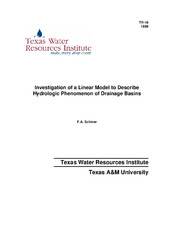| dc.description.abstract | This investigation is concerned with the applicability of the linear convolution relationship for approximating the rainfall-runoff phenomenon for small drainage basins. A solution for the transfer function of the convolution relationship is obtained by employing discrete mathematics similar to the Wiener-Hopf equation. The solution is obtained, based on the restraints of the physical system by linear programming.
In this investigation, the hydrologic system is analyzed as a truly linear system. Recorded rainfall intensity is the input of the system, and recorded runoff output. A major concern of the study involves the effects of antecedent moisture conditions on the transfer function.
Two basins are used to test the model -- an urban basin located within the city limits of Bryan, Texas and a rural basin approximately three miles east of Bryan, Texas. Results are presented which substantiate the use of the proposed linear model as an approximation to the hydrologic system. Generalized transfer functions are developed for each basin and tested with independent events. Antecedent moisture conditions are shown to have a definite predictable effect on the transfer function, and rainfall events are classified with an antecedent moisture condition criteria in order to select the proper transfer function for the event. | en |


